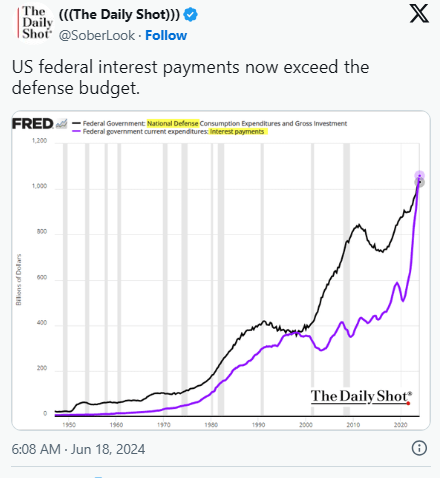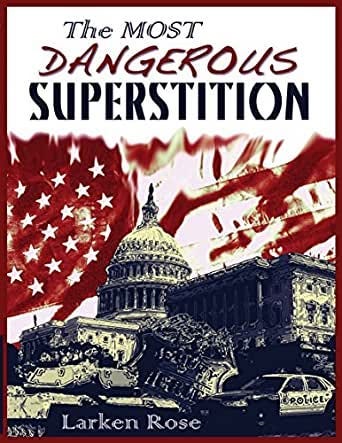Interest on National Debt Surpasses Defense Spending
Interest on the national debt is rapidly becoming the biggest single category of spending by the U.S. government. As of May 2024
Interest on the national debt is rapidly becoming the biggest single category of spending by the U.S. government. As of May 2024, the amount of money spent to pay interest owed to the federal government’s creditors surpasses the annual amount it spends on national defense.
The Daily Shot tweeted the grim milestone:
Defense spending represents the largest category of discretionary spending by the U.S. government appropriated by the U.S. Congress each year. Interest on the national debt represents mandatory spending. It now ranks third behind the annual spending to fund other mandatory spending programs like Social Security and Medicare.
Fueled by excessive spending, the growth of the national debt and the surging amount of interest that must be paid on it is crowding out other parts of the U.S. government’s spending. The Biden administration announced it will cut some Medicare benefits starting in January 2025.
Part of the problem is how the Biden administration manages the national debt. After making the worst fiscal blunder in the department’s history in 2021, the U.S. Treasury Department is now gambling on interest rates falling.
The Treasury Department’s Gamble
That gamble came to light during Treasury Secretary Janet Yellen’s recent testimony before the U.S. Congress.
Republican Senator John Kennedy and Bill Hagerty criticized Yellen for issuing debt at higher interest rates amid an inverted yield curve. Currently the yield on the benchmark 10-year Treasury note is 4.33%, compared to 5.4% on the three-month Treasury bill.
Kennedy accused Yellen of deliberately boosting short-term debt to spur growth during an election year, suggesting this was putting downward pressure on long-term rates.
“You’re paying 5 percent to borrow money, when you could pay 4 percent to borrow money,” Kennedy said. “You’re working at cross purposes with (Federal Reserve Chair) Jay Powell. And the reason you’re doing this is to try to give the economy a sugar high five months before the election,” he said.
Yellen replied: “There’s nothing about issuing short term debt that creates a sugar high for the economy.”
She told the senator that market participants anticipate that short term rates will fall to substantially under 4.5%, so locking in debt for 10 years at current rates would likely result in higher long-term borrowing costs than the current path.
Short-term interest rates have risen higher than long-term rates because the Federal Reserve raised them to combat inflation unleashed by the Biden administration’s 2021 fiscal stimulus. Because that inflation persists, the Fed has held those rates higher for much longer than many market participants, including bureaucrats like Yellen, who manage the U.S. government’s debt, ever anticipated.
Yellen’s national debt management strategy represents a losing gamble with guaranteed losses as long as that state of affairs continues. Even winning her bet would come with pain because the Fed often cuts interest rates in the face of economic recessions.
Investor Gary Shilling had a useful insight into this scenario based on his investment management experience. “The market can remain irrational longer than you can remain solvent.”
There’s a reason economics is widely known as the dismal science.
The Most Dangerous Superstition by Larken Rose - exposes the myth for what it is, showing how nearly everyone, as a result of one particular unquestioned assumption, directly contributes to violence and oppression without even realizing it. $14 ( or $60 with "Government" and a Liberator drive)







